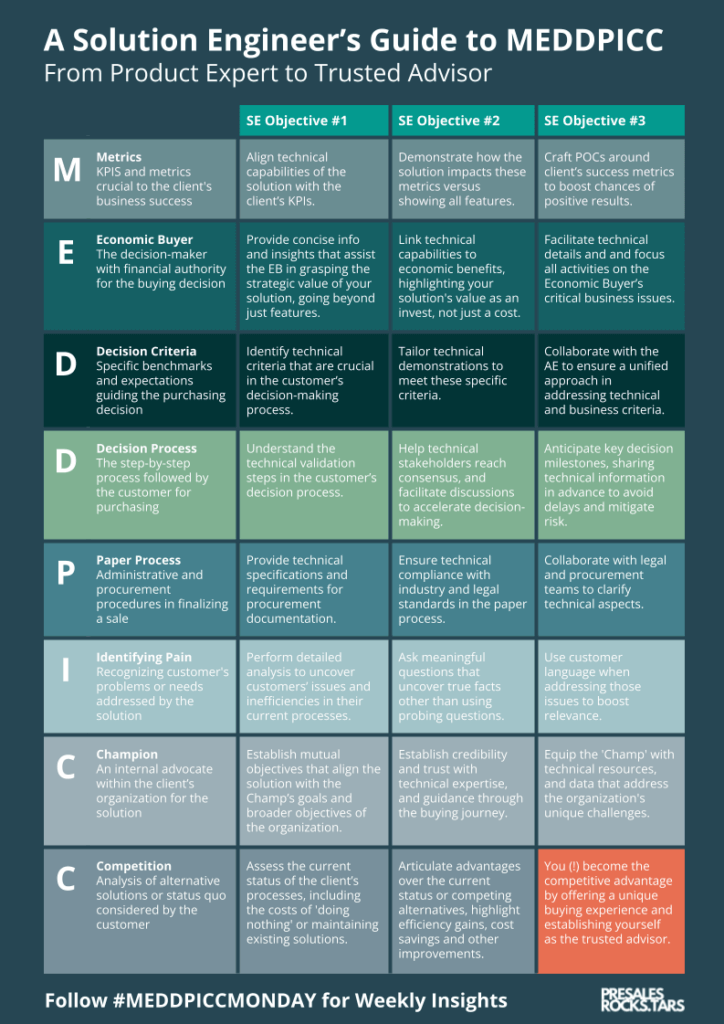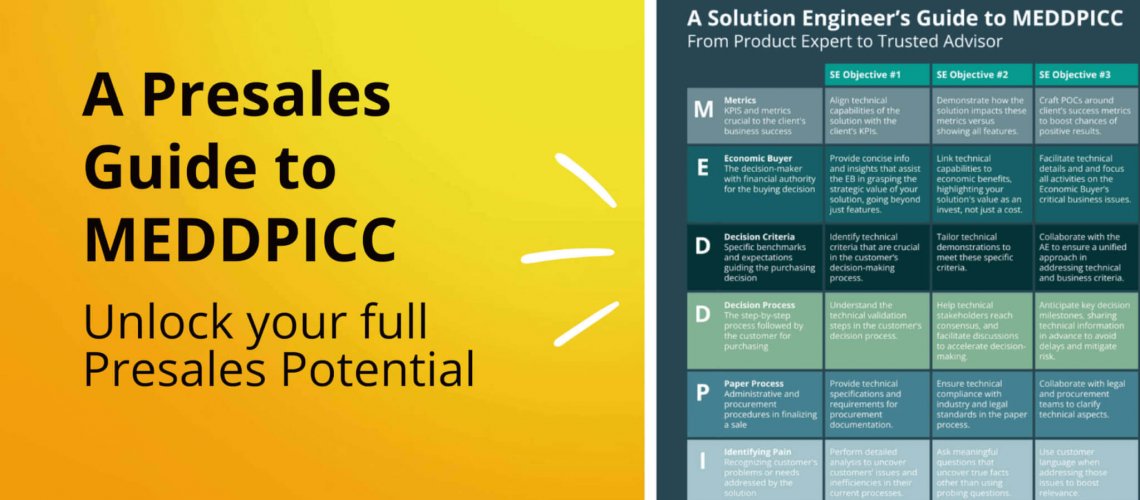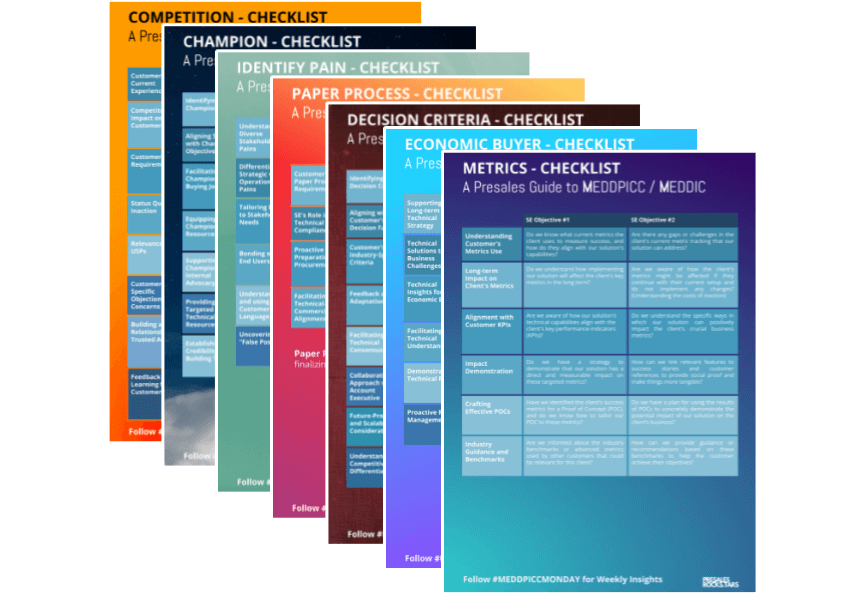MEDDPICC (or MEDDIC / MEDDPIC) is a well-known method in the sales world, focusing on Metrics, Economic Buyer, Decision Criteria, Decision Process, Identify Pain, Champion, Compelling Event, and Competition. It’s traditionally used by sales teams to evaluate deals, ensuring nothing important is missed. This method helps spot potential issues and make smart choices about business opportunities.
But MEDDPICC is more than just a sales tool. It’s especially useful for Solution Engineers (SEs). SEs have a mix of technical skills, industry knowledge, and customer understanding. They are perfect for using MEDDPICC in new ways, beyond just selling.
SEs can use MEDDPICC to create better experiences for their clients. It’s not just about selling a product; it’s about matching it with the client’s specific needs, as seen through MEDDPICC. For example, focusing on ‚Metrics‘, SEs can show how their solution helps with the client’s key goals, making the engagement more meaningful.
SEs can also use their deep technical and industry knowledge with MEDDPICC to stand out in sales. They become more than product experts; they become strategic advisors offering solutions tailored to the client’s business context.
In short, MEDDPICC for SEs means shifting from an internal tool to a strategic framework for building stronger, insightful connections with customers. This not only improves customer experience but also leads to more effective sales. SEs become key in aligning sales strategies with customer-centric values, benefiting both the seller and the client.
TL;DR: Maximizing Presales Performance with MEDDPICC / MEDDPICC Framework:
- A vital tool for Solution Engineers (SEs) to deepen customer engagement, moving beyond basic sales methods.
- Tailoring to Customer Needs: Through MEDDPICC, SEs precisely align their solutions with the specific requirements and objectives of customers, shifting from mere technical sales to forming strategic partnerships.
- Competitive Edge: This framework equips SEs to stand out in a crowded market by concentrating on the distinct challenges faced by each customer.
- Comprehensive Insight: MEDDPICC directs SEs to thoroughly comprehend every aspect of a sales deal, from the customer’s decision-making journey to pinpointing specific challenges and capitalizing on urgent needs.
- Fostering Trust: The approach focuses on building solid, trust-based customer relationships, resulting in improved sales performance and heightened customer satisfaction.
- More Than Just a Sale: MEDDPICC enables SEs to deliver solutions that go beyond mere products, positioning them as key strategic resources for the customer’s long-term success, and laying the groundwork for enduring partnerships.

Metrics in the MEDDPICC Method: Customizing Solutions to Fit Customer Objectives
Within the MEDDPICC model, ‚Metrics‘ are crucial, particularly for Solution Engineers (SEs). In this context, metrics are the measurable standards a business uses to gauge success. For SEs, it’s vital to grasp and align with these metrics, as it’s key to crafting solutions that not only meet but surpass client goals.
Effectively using metrics hinges on the SE’s skill to connect their solution with the client’s key performance indicators (KPIs). This involves a thorough understanding of the client’s top priorities, whether it’s boosting efficiency, cutting costs, or fostering innovation. For example, if a client values operational efficiency, an SE can illustrate how their solution optimizes processes, thus saving time and resources.
Aligning solutions with client metrics means not only addressing current needs but also looking ahead to future demands. This forward-thinking approach allows SEs to offer solutions that tackle present issues while providing ongoing advantages. For instance, if a client plans to expand, an SE could highlight how their cloud solution can scale in parallel with the client’s growth, aligning with scalability as a key metric.
Communicating these alignments effectively is another critical skill. SEs should convey how their solution impacts the client’s metrics in a clear, relatable manner, ensuring the solution doesn’t come across as overly complex.
Furthermore, customizing solutions to fit metrics also involves adapting to shifts in the client’s business landscape. SEs should remain in tune with changes in client priorities and modify their solutions to match. This adaptable approach not only shows the SE’s dedication to meeting the evolving needs of the client but also fortifies the relationship, positioning the SE as a dependable and proactive ally.
In conclusion, utilizing metrics effectively in aligning solutions with client objectives is a complex task. It demands a deep understanding of the client, strategic foresight, clear communication, and the ability to adapt. By excelling in this aspect of the MEDDPICC framework, SEs can greatly improve the relevance and effectiveness of their solutions, leading to more fruitful client interactions and ultimately, enhanced sales results.
Understanding the Economic Buyer in MEDDPICC: Seeing the Bigger Picture
The Economic Buyer in a sales process is usually a high-level executive or main decision-maker who looks at the big strategic goals, not just the small technical parts of a product. For Solution Engineers (SEs), the key goal is to show how the technical features of a solution can bring major business benefits. This is different from talking to end-users, who are more interested in how the solution works every day.
When SEs talk to Economic Buyers, they should focus on how their solution helps with the company’s larger strategic plans. This means making complex technical details easy to understand and showing how they can lead to business wins like better returns on investment, beating competitors, and growing in the market.
SEs also need to be ready to explain how their solution can improve the company’s profits, make operations smoother, or bring new ideas, always connecting these benefits to what the Economic Buyer wants to achieve.
It’s important for SEs to understand the business world and the specific problems the Economic Buyer’s company faces. SEs should show they know about current industry trends, rules, and competition, as these can affect the buyer’s choices. By showing how their solution fits into these bigger issues, SEs can make their product seem even more relevant to the Economic Buyer’s plans.
In short, to connect well with Economic Buyers, SEs need to focus more on how their solutions help with big business goals, not just the technical details. By clearly showing how their solutions support and improve the company’s big plans, SEs can become important partners to Economic Buyers, making it more likely that they will succeed in selling their solutions.
Decision Process in MEDDPICC: Making Customer Interaction Smoother
Knowing how customers decide to buy is really important for Solution Engineers (SEs). In the MEDDPICC method, understanding the customer’s decision process is crucial. This process has many steps, from when a customer first realizes they need something to when they finally decide to buy it.
For SEs, it’s not just about knowing what the customer needs. They need to really understand how and when the customer makes decisions. This means SEs can make their presentations and talks fit perfectly with where the customer is in their decision process and how much detail they need. For example, at the start, SEs should focus on introducing their solution and its main benefits. Later, they can get into the more detailed technical stuff and show how it works just for that customer.
SEs also need to think ahead about any problems or questions that might come up at different points in the process. Like, if a customer is worried about how a new system will work with their current one, an SE who’s ready for this can show them how it can be integrated smoothly.
In real situations, the best SEs use their knowledge to help guide the customer through each step. They might share stories about how they solved similar problems for other customers. This not only gives practical examples but also helps build trust with the customer, making the SE more than just someone who sells something.
SEs also need to change how they talk and interact based on the size of the company, its culture, and how it works inside. This flexibility makes sure the technical information is not just relevant but also really connects with everyone involved in making the decision.
To sum up, being good at guiding customers through their decision process is a key skill for SEs. It lets them adjust how they talk and what they focus on so that their technical know-how is used at just the right time. This approach not only makes it easier for customers to decide but also increases the chances of making a successful sale.
Decision Criteria in MEDDPICC: Helping Customers Choose Easier
For Solution Engineers (SEs), really understanding what customers look at when deciding is key to shaping their strategies and making the decision process smoother. Decision criteria are the specific things and standards customers use to pick a solution. These usually include how well the solution fits technically, if it works with what they already have, how it helps their business goals, and if it fits into their overall strategy.
It’s really important for SEs to figure out and understand these criteria. This helps them tailor their solutions and how they talk about them to match exactly what the customer is looking for. This starts with a deep dive into what the customer needs, often working together with other team members like Account Executives. By making sure their solution lines up well with these criteria, SEs can make their proposals much more attractive and relevant.
A good way for SEs to do this is to have proactive meetings with the customer to really get to the bottom of what they need and what’s important to them. For example, if a customer is focused on being able to grow in the future, they’ll probably like solutions that can grow too. In these cases, SEs should show how their solution can adapt as the business changes and grows.
SEs also need to be good at understanding not just what’s said outright, but also what might be implied, like in Request for Proposals (RFPs) or first meetings. For example, if a customer talks a lot about security, they might also be interested in solutions that are really compliant, even if they don’t say it directly.
In real situations, smart SEs use things like custom demos and Proof of Concepts (POCs) to show how their solutions meet these decision criteria. Like, if a customer really cares about how well a new solution works with their current systems, an SE can show how seamlessly their product can be integrated.
To wrap up, getting and using the customer’s decision criteria is a really important skill for SEs. It’s about listening well, asking the right questions, and showing solutions in a way that really fits what the customer wants. By getting better at these things, SEs can guide their customers through choosing a solution more effectively, offering options that meet the technical needs but also fit well with the customer’s bigger business goals. This not only makes deciding easier but also helps SEs become trusted advisors to their customers.
Paper Process in MEDDPICC: Handling the Final Steps Before a Sale
The ‚Paper Process‘ in the MEDDPICC method is a crucial stage that can make or break a deal. It covers all the administrative and procedural steps from when a solution is proposed until it’s bought. This stage is more than just filling out forms. It involves coordinating logistics, procedures, and technical details, which are all key to a successful and efficient sale.
Solution Engineers (SEs) need to be ready for and manage all the steps needed to finish a deal. This includes giving detailed technical information, making sure everything meets industry and legal rules, and working well with the Account Executive and legal and procurement teams. It’s important that all the technical parts of the solution are correctly shown in the buying documents.
One way SEs can make this process faster is by managing technical documents proactively. For instance, when a customer is buying a complex CRM system, the SE can help a lot by guiding them through all these steps. This means preparing complete technical details and making sure these meet the customer’s internal needs and follow all the rules, having all the documents ready beforehand to avoid going back and forth.
Another important part is knowing the approval and buying steps. SEs should know who has to approve each part of the purchase and what documents are needed. By planning for these requirements, SEs can make the process smoother, reducing delays and confusion. For example, if a company needs a lot of checks to make sure everything is compliant, the SE should work closely with both the customer’s and their own legal teams to make sure all the right certifications and documents are in place.
To sum up, the Paper Process is where technical details meet buying rules. SEs who are good at this not only make finishing the deal smoother but also show they are dedicated to a thorough and customer-focused approach. By managing the Paper Process well, SEs can make the whole sales cycle more efficient and speed things up by dealing with important issues like compliance and security early on.
Identify Pain in MEDDPICC: Finding and Solving Customer Problems
In the MEDDPICC framework, being able to ‚Identify Pain‘ is very important for Solution Engineers (SEs). This means figuring out and solving the specific problems or issues that a customer is dealing with. This skill is really important in making sales successful because it has a big impact on how the customer decides what to buy.
To really understand what problems customers have, SEs need to get into the details of how the customer’s business works. They should ask open questions that help find out what everyday problems the customer faces.
For instance, if a client is having trouble managing their data, an SE should look into how they’re currently doing things and what specific problems they have. This helps find deeper issues that might not be obvious at first.
Once SEs know what these problems are, they need to show how their solutions can fix these issues in a clear and useful way. For example, if a customer finds it hard to keep track of sales, an SE could suggest a new CRM system that makes this easier and more efficient.
It’s also important to solve not just the big strategic problems that are usually discussed with the main decision-makers but also the everyday problems that regular users face. Regular users might have different issues, like problems with how easy a product is to use or how well it fits into their daily work. SEs should talk to these users to understand these everyday challenges and explain how their solutions can help.
When talking to regular users, SEs need to change how they communicate, focusing more on practical things than big strategic benefits. By dealing with the actual, day-to-day problems that users have, SEs can build better relationships and trust with these important people. This approach makes sure the solution works well for everyone involved and shows that the SE really understands both the big picture and the day-to-day needs of the business.
In conclusion, being able to find and fix both the big and the small problems in a business is a key skill for SEs. It needs a mix of good questioning, deep understanding of how things work, and the ability to explain solutions well to different people. Being good at this part of the MEDDPICC method helps SEs offer solutions that cover both technical and practical needs, making their relationships with all kinds of customers, especially regular users, much stronger.
Champion in MEDDPICC: Creating Strong Supporters in the Client’s Company
In selling, a lot depends on having a ‚Champion‘ inside the client’s company. Champions are more than just supportive contacts; they are key allies who can really sway decisions inside the company. For Solution Engineers (SEs), it’s crucial to build relationships with these Champions to help steer the sale towards success.
Champions are people in the client’s company who see the worth of the SE’s solution and have the power to support it. To find the right Champion, SEs need to understand the way the client’s company works and find people who will benefit from the solution and can make changes happen.
Once SEs find a potential Champion, they need to become trusted advisors. This means making sure their solution fits with what the Champion wants and showing how it can help them both personally and professionally. Tailoring their approach to match the Champion’s interests is key to building a strong, working relationship.
Giving the Champion detailed information about the product, success stories, and insights is important so they can effectively support the solution inside the company. This means giving them the tools and knowledge they need to clearly explain the benefits of the solution in a way that fits with the company’s goals.
Keeping a good relationship with the Champion also means staying in touch regularly and offering support. SEs should be proactive in helping the Champion with their efforts to get support inside the company. This support should go beyond just giving product details and help the Champion deal with any challenges they might face in the company.
SEs should also think ahead about what the Champion will need next and give advice to avoid any problems. This kind of forward-thinking and active support is really important to keep the Champion’s trust. By offering solutions and advice that go beyond the product and focus on the Champion’s best interests, SEs can make their relationship with the Champion even stronger. This not only helps the Champion support the solution inside the company but also makes the SE a valued partner, not just a seller.
Sometimes, Champions might not know much about buying complex software, which can make them unsure about the steps and rules they need to follow. In these cases, SEs need to guide them to make sure everything goes smoothly and there are no unexpected problems because something was missed.
Since many companies have similar buying processes, an experienced SE should be able to guide the Champion well. For example, they might need to involve the workers‘ council early on, especially if the software deals with employee data. This step is often forgotten but is really important because the workers‘ council can have a lot of say. By telling the Champion to talk to the workers‘ council early and giving them the right information and story, SEs can help avoid delays. This not only saves time but also makes the relationship with the Champion stronger by showing that the SE is helping them handle complex issues in the company.
In conclusion, building relationships with Champions in a client’s company is a key strategy for SEs. By finding influential people, making sure solutions fit their goals, and giving them the right tools and information, SEs can use these relationships well. Planning ahead, giving strategic advice, and focusing on what’s best for the Champion makes this relationship even stronger, speeding up the sale and making SEs essential partners in the client’s company.
Compelling Event in MEDDPICC: The Role of Key Deadlines and Factors
For Solution Engineers (SEs), using ‚Compelling Events‘ wisely is a very important strategy. A Compelling Event is a specific deadline or an important factor in a customer’s organization that makes a solution urgently needed. This could range from changes in laws or shifts in the market to important goals within the company that require quick action.
These events are extremely important in selling. They not only make a deal urgent but also play a big role in deciding when the customer will make a choice. For SEs, recognizing these events and showing how their solution fits with them can make their proposal much more relevant and urgent.
For instance, imagine a company needs to meet new data security rules by a certain date. This deadline is the Compelling Event. If an SE can show that their security solution meets this deadline, their proposal becomes much more than just an option – it becomes a must-have. By showing how their solution helps the company meet these rules on time, the SE highlights how important their solution is and the risks of not acting quickly.
Another example is a company getting ready to grow significantly. Here, the Compelling Event might be the date they plan to start this growth. An SE using this event would focus on how their solution makes this growth smoother and more effective, making their product a key part of the customer’s plans.
In these situations, an SE’s understanding of Compelling Events is more than just knowing what the customer needs technically. It’s about really understanding both the outside and inside factors that make the customer act fast. This knowledge lets SEs tailor how they talk and what they provide, focusing on how their solution meets the customer’s urgent needs in the right time frame.
Also, it’s important to know the difference between the Compelling Event and when the deal is supposed to close. The closing date is when the sale is supposed to finish, but the Compelling Event is about when the customer really needs things done. By matching their solutions to these events, SEs show that they are thinking about what the customer needs, not just about finishing the sale.
To sum up, Compelling Events are much more than just deadlines. They are crucial parts of the selling process. By identifying, understanding, and matching solutions to these events, SEs can make a strong case for their solutions, showing how important and timely they are for meeting the customer’s immediate needs.
Competition in MEDDPICC: Understanding and Outdoing the Competition and Status Quo
In the MEDDPICC framework, dealing with competition is a key part for Solution Engineers (SEs). It’s not enough to just know who the competitors are. SEs also need to understand the customer’s current situation and why they might prefer to keep things as they are. The ‚Competition/Customer Solution‘ part of MEDDPICC highlights the importance of SEs making their solutions stand out in a market full of choices.
Doing deep research on competitors is a basic step for SEs. This means looking closely at what competitors offer, what they’re good at, and where they’re weak. This information helps SEs shape their solutions to meet the specific needs and goals of the client, focusing on areas where they can really make a difference.
When dealing with competition, SEs should keep a balanced approach. It’s not good to speak badly of other products. Instead, they should focus on what makes the customer’s situation unique. SEs should match the best features of their solution (USPs) with these unique needs, showing why their solution is not just different, but better for what the customer specifically needs. This means really understanding the customer’s business and presenting a solution that fits well with what the customer wants to achieve.
If an SE is competing against what the customer already has or their hesitation to change, they should clearly show why the new solution is better. This includes pointing out how the new solution uses the latest technology, works better, and fits more with where the business is going. It’s important for SEs to think about what the customer loses by sticking with their current setup, like missed chances for better efficiency, growth, and innovation. By showing these lost opportunities, SEs can make a strong case for their solution, showing how it can solve current problems and open new possibilities.
By carefully following every part of the MEDDPICC method, SEs become a big advantage themselves. By fully understanding and addressing each area — Metrics, Economic Buyer, Decision Criteria, Decision and Paper Process, Identify Pain, Champion, Compelling Event, and Competition/Customer Solution — SEs bring a lot more value than just their product.
Customers often like this approach, as it shows the SE is committed to not just selling something but offering a complete, customized solution that meets their specific needs and problems. Being good at dealing with competition and adding extra value makes SEs really important. This not only makes their solution more attractive but also makes them trusted advisors, improving the customer’s experience and the chances of a successful sale.
In short, dealing with competition well means SEs need to do detailed research, understand what the customer loses by not changing, and focus on the unique benefits of their solution. By concentrating on the customer’s problems and matching their solution’s best features with these problems, SEs can offer something that’s not just another option, but a strategic improvement. This not only makes their solution stand out but also makes the SE a trusted advisor, adding a lot to the customer’s decision-making process.
Final Reflections on MEDDPICC: Enhancing the Impact of Solution Engineers
To wrap it up, the MEDDPICC framework is far more than a mere checklist for sales deal analysis. It serves as a robust guide that empowers Solution Engineers (SEs) to establish a deep connection with their clients. Through MEDDPICC, SEs go beyond mere product selling; they finely tune their solutions to match the specific needs and desires of the customer.
This method transforms the role of SEs. They evolve from discussing mere technical specifics to becoming reliable partners, offering solutions that are perfectly in sync with the customer’s business operations. They gain an intimate understanding of their customers‘ businesses, enabling them to address not only existing issues but also to prepare for future challenges.
One of the greatest strengths of MEDDPICC lies in its ability to help SEs stand out in a highly competitive market. It’s not solely about being aware of what competitors are offering. More importantly, it’s about grasping the distinct challenges faced by each customer and demonstrating how their solution is the optimal choice.
By fully incorporating MEDDPICC into their professional approach, SEs elevate their importance in the sales process. They transition from being simple product experts to becoming crucial contributors to the customer’s success. This shift leads to stronger customer relationships, improved sales outcomes, and heightened customer satisfaction.
Ultimately, embracing MEDDPICC means that SEs adopt a customer-centric mindset, prioritizing the establishment of enduring business relationships. This customer-first philosophy paves the way for genuine success for both the SEs and their clients, proving that MEDDPICC is a powerful tool for enhancing the effectiveness and impact of Solution Engineers.





